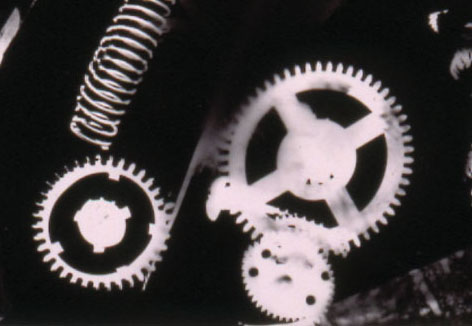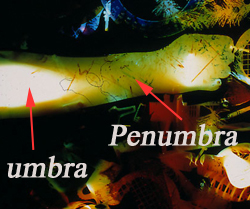|
When
working with photographic negative processes, either black &
white or colour, any object laid on the paper will print as
a negative image AS mentioned, the object will block the light
and leave a white shadow on the paper where it blocked the light
from reaching the paper. The size, shape and tones of the photogram
relate directly to the objects laid on the paper.
|
Solid
or opaque objects

silhouette photogram of small
gears and a spring
|
Opaque
Objects
When
working with standard black and white photographic
paper, solid objects (opaque) that block the light
out completely from reaching the paper produce a simple
silhouette style image on the paper when developed
in the standard manner. If the exposure time is right,
the shape of the object laid on the paper will be
white and the background black.
Almost
any opaque object will do, small metal objects like
keys, coins, chains, rings etc. work well for this,
but even your hand or finger will work. Life size work
using the full human body laid on the paper to block
the light has even been used. I created some full figure photograms images for the Evidence from
Religion of Technology project.
Umbra
Objects in direct physical contact with the
emulsion and block the light completely, will
record as white in the print (I use the astronomical
term Umbra to describe these as
areas).
Penumbra
Areas of an object that are not in direct physical
contact will record as various tones of caused
by light reflecting under the object and inwards
onto the paper. Rather than a simple silhouette,
this can add a three dimensional quality to
the representation of the object. (I use the
astronomical term Penumbra to reference
these as areas). |
 |
Nebula
Depending upon the physical nature and surface
qualities of the object, light can also reflect
outwards from the object across the paper, creating
a variety of marks and tones. This is
more likely to record in areas like the example
of the adjacent arm and hand.
In
the image of the arm and closed fist highly
reflective Christmas tinsel foil has created
a strange variety of light reflections and projected
them under the hand and wrist. (I use the astronomical
term Nebula to reference these as
areas).
|
 |
Some
wonderfully abstract image can be created with very
simple, and quite ordinary objects.
Paper
and Foil Materials
A
range of shapes can be cut out of highly reflective
aluminum tin foil and different types of paper of
varying thickness, transparency and quality. These
can be laid on the photo paper with good effect
in the resulting photogram. Sections of the paper
can be over lapped, the edges can be either cut
or torn, they can be laid flat, curved up or even
screwed up in a ball and then flattened out again.
Like wise sections of thin foil can be curved up,
cricked etc.
|
|
(I have even worked with full-scale figures, and several
people at once making the exposure with the enlarger
bolted to the ceiling or using a studio flash
light.) Evidence
from the Religion of Technology a project
using full the human figure to make photograms.
|
|